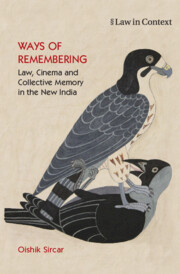Book contents
- Frontmatter
- Dedication
- Contents
- List of Figures
- Acknowledgements
- List of Abbreviations
- 1 Law and the Aesthetics of Atrocity
- 2 A Jurisprudential-Aesthetic Approach
- 3 The Best Bakery Judgments: Aesthetics of Judicial Memory
- 4 Bollywood’s Law: Cinematic Justice and Collective Memory
- 5 ‘As They Ought’
- Notes
- Glossary
- Bibliography
- Index
4 - Bollywood’s Law: Cinematic Justice and Collective Memory
Published online by Cambridge University Press: 30 April 2024
- Frontmatter
- Dedication
- Contents
- List of Figures
- Acknowledgements
- List of Abbreviations
- 1 Law and the Aesthetics of Atrocity
- 2 A Jurisprudential-Aesthetic Approach
- 3 The Best Bakery Judgments: Aesthetics of Judicial Memory
- 4 Bollywood’s Law: Cinematic Justice and Collective Memory
- 5 ‘As They Ought’
- Notes
- Glossary
- Bibliography
- Index
Summary
[T]he cinematic image is written in time, in the body, in sound, tactility and memory.
The film positions us to judge with our entire bodies … the techniques of image and sound … press the viewer towards a more open space of judgment, one in which new meanings must be constructed, one in which the viewer will have to actively participate.
[T]o see what law is go to the cinema.
This chapter uses the J-A approach to read (see and hear) three Bollywood feature films that make the Gujarat pogrom central to their plots. The films are Dev, Parzania and Kai Po Che, whose release dates span the period 2004–13, overlapping with the Best Bakery case. Attention to this shared memorial journey of the judicial and the cinematic will further reveal their narrative compact in the making and ordering of collective memories of the pogrom.
I show how narrative tropes and cinematic techniques are used and repeated in the films to reconstruct the memory of the pogrom and project imaginations of justice. The J-A lens examines how the films mobilise spectatorial publics, by bestowing on them the authority to pass judgment on both the cinema and the pogrom. The films severally and collectively train their publics in ways of remembering the pogrom as a story of the triumph of secular law over religious violence. In this way of remembering, the lineaments of the New India—the work of the state-making and state-preserving rationalities in legalism, secularism and developmentalism—become visible in the texts of the films.
In my J-A reading of the texts of judgments in the previous chapter, the judgment form was considered to be a record of images, by way of the aesthetic tropes embedded in their language. In my J-A reading of the films in this chapter, I will pay attention to how the cinematic form brings together word, image and sound to mobilise judgment.
The chapter opens with a brief explanation of how each of these films inaugurates a relationship between cinema and the spectator through the use of a specifically Indian practice of state-sanctioned legal certification and a standard disclaimer.
- Type
- Chapter
- Information
- Ways of RememberingLaw, Cinema and Collective Memory in the New India, pp. 94 - 156Publisher: Cambridge University PressPrint publication year: 2024

